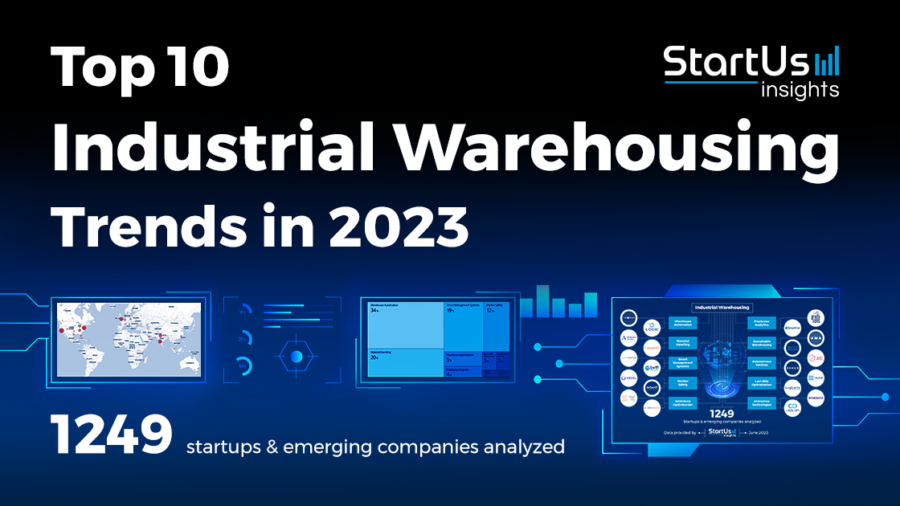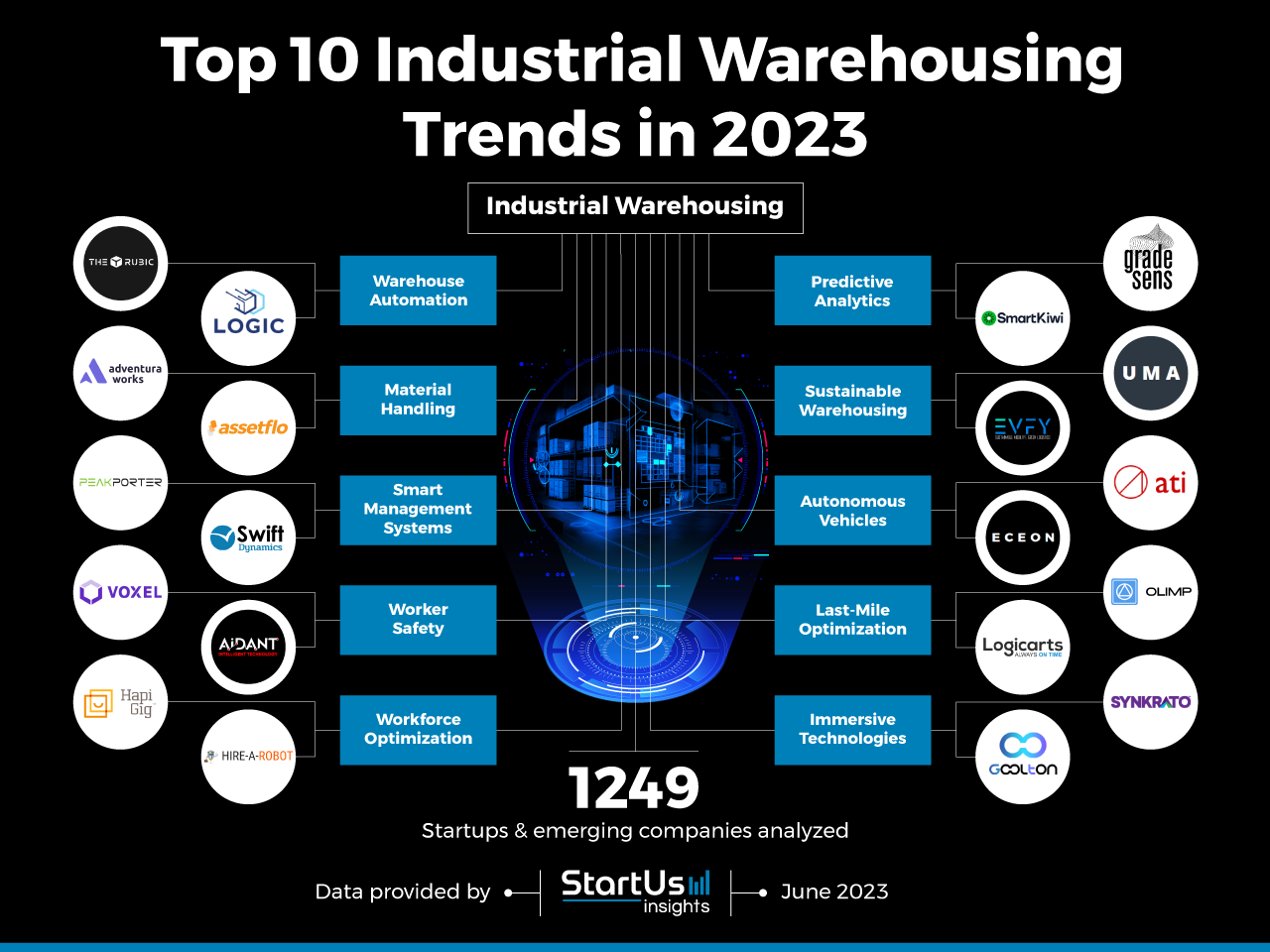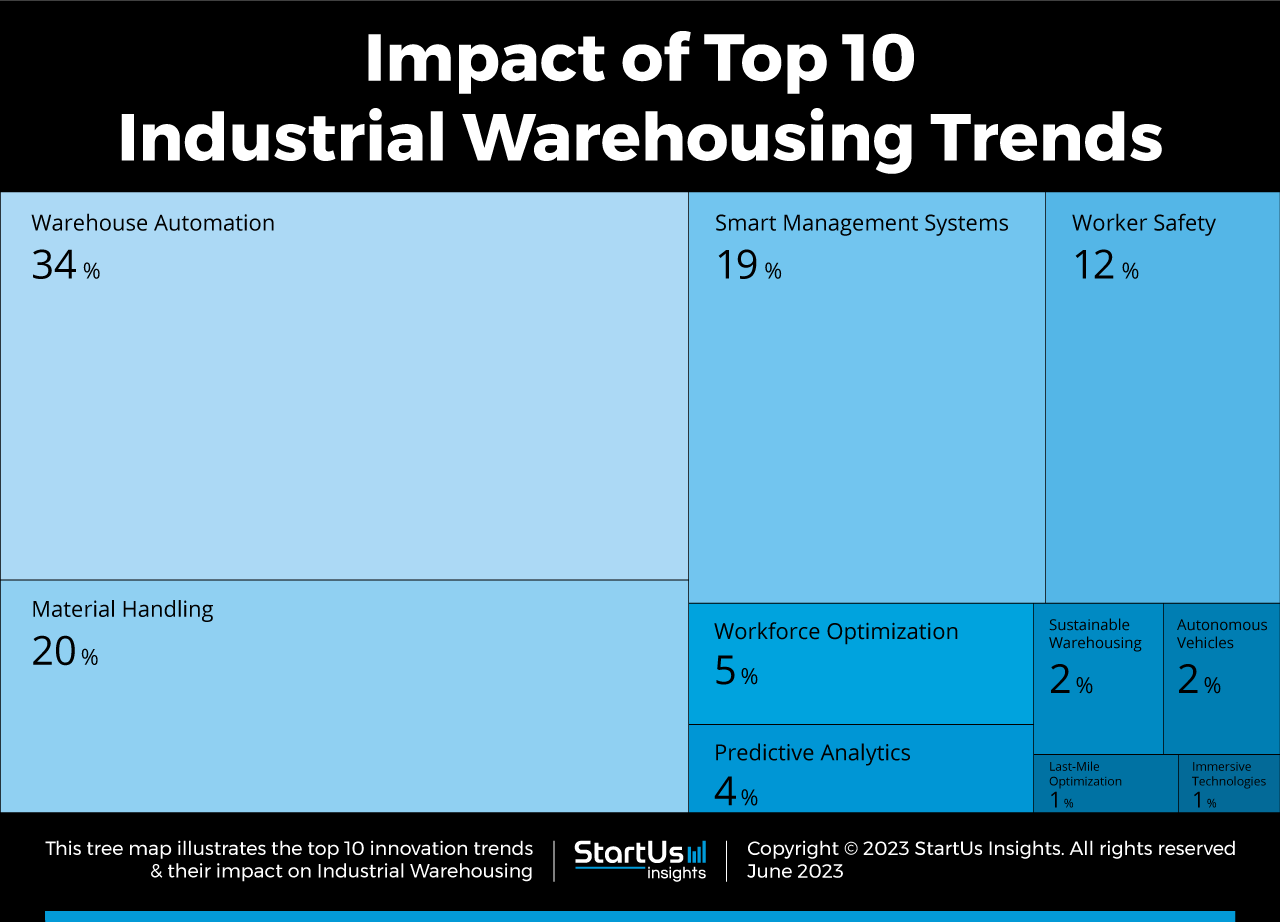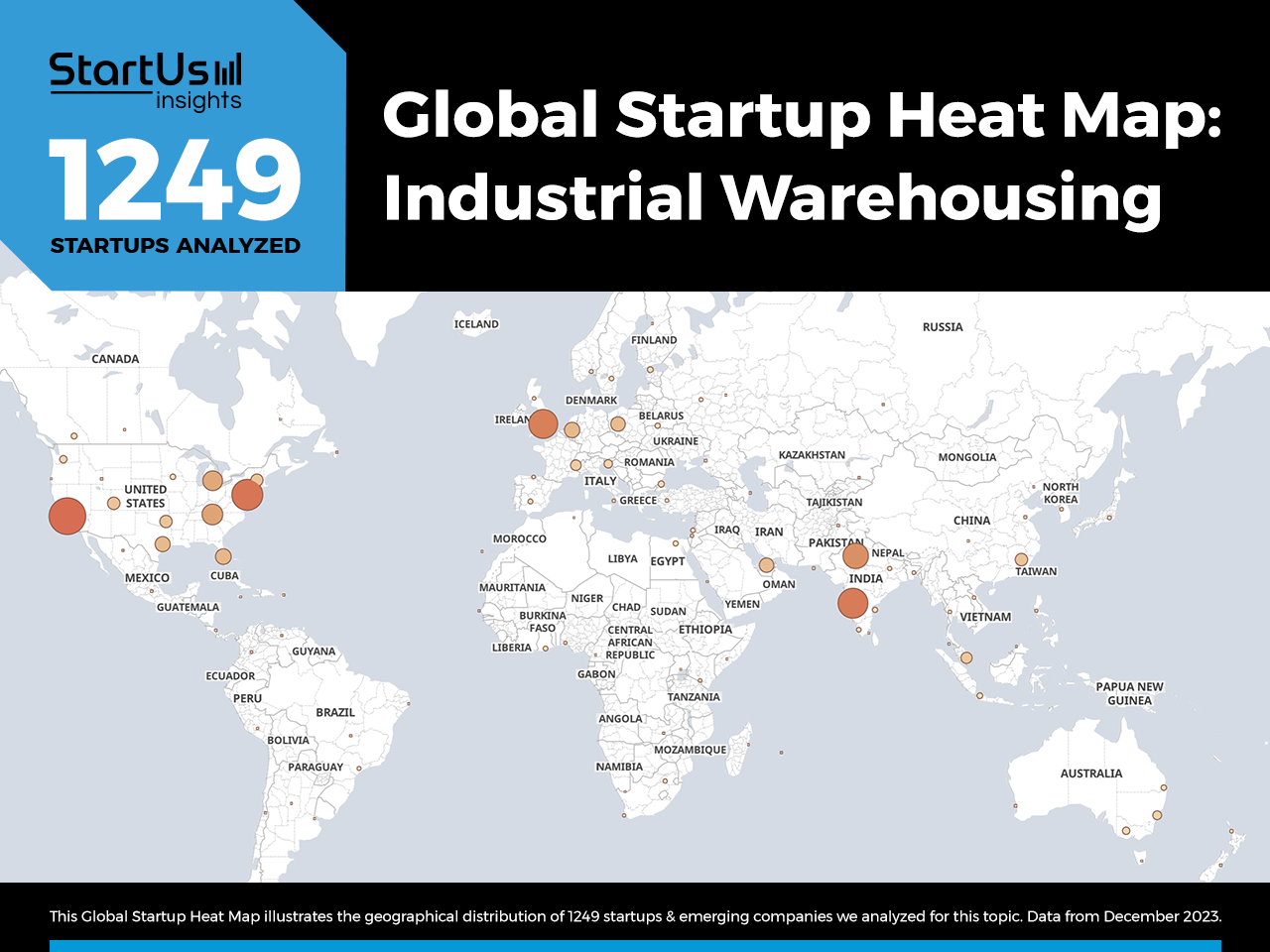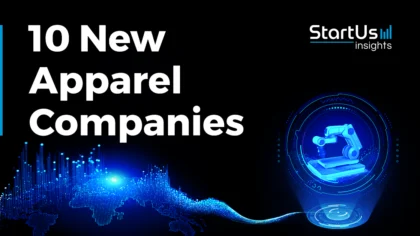From automation and robotics to predictive analytics and immersive technologies, industrial warehouses are leveraging cutting-edge technologies to improve efficiency and reduce costs. In this dynamic business environment, it is essential for industrial warehouses to stay up-to-date with the latest warehousing technologies and trends. This article explores the top 10 industrial warehousing trends and emerging technologies that are shaping the future of the industry. They range from warehouse automation and immersive technologies to sustainable warehousing and worker safety. Read more to explore each trend and discover how they impact your business.
Innovation Map outlines the Top 10 Industrial Warehousing Trends & 1249 Promising Startups
For this in-depth research on the Top Industrial Warehousing Trends & Startups, we analyzed a sample of 1249 global startups & scaleups. This data-driven research provides innovation intelligence that helps you improve strategic decision-making by giving you an overview of emerging technologies in the warehousing and logistics industry. In the Industrial Warehousing Innovation Map, you get a comprehensive overview of the innovation trends & startups that impact your company.
These insights are derived by working with our Big Data & Artificial Intelligence-powered StartUs Insights Discovery Platform, covering 3 790 000+ startups & scaleups globally. As the world’s largest resource for data on emerging companies, the SaaS platform enables you to identify relevant technologies and industry trends quickly & exhaustively.
Tree Map reveals the Impact of the Top 10 Trends in Industrial Warehousing
Based on the Industrial Warehousing Innovation Map, the Tree Map below illustrates the impact of the Top Industrial Warehousing Industry Trends in 2024. Companies are developing automation solutions to increase efficiency and reduce operational costs in industrial warehouses. Material handling systems, such as automated storage and retrieval systems (AS/RS), allow for efficient goods storage and retrieval. Additionally, the use of robotics improves the speed and accuracy of order picking, in turn, reducing the time to fulfill orders.
Another technology impacting industrial warehousing is worker safety and management by utilizing smart management systems. This improves inventory management and reduces downtime due to equipment failure. Finally, the use of artificial intelligence (AI) enables predictive maintenance, which prevents equipment failure, further reducing downtime and maintenance costs. Other innovations, including immersive technologies and autonomous vehicles, in industrial warehousing drive sustainability and last-mile optimization.
Top 10 Trends in Industrial Warehousing (2024)
- Warehouse Automation
- Material Handling
- Smart Management Systems
- Worker Safety
- Workforce Optimization
- Predictive Analytics
- Sustainable Warehousing
- Autonomous Vehicles
- Last-Mile Optimization
- Immersive Technologies
Global Startup Heat Map covers 1249 Industrial Warehousing Startups & Scaleups
The Global Startup Heat Map below highlights the global distribution of the 1249 exemplary startups & scaleups that we analyzed for this research. Created through the StartUs Insights Discovery Platform, the Heat Map reveals high startup activity in the US and India, followed by the UK. Below, you get to meet 20 out of these 1249 promising startups & scaleups as well as the solutions they develop. These emerging industrial warehousing companies are hand-picked based on criteria such as founding year, location, funding raised & more. Depending on your specific needs, your top picks might look entirely different.
Top 10 Industrial Warehousing Trends in 2024
1. Warehouse Automation
Automation plays a crucial role in industrial warehousing, changing the way goods are stored, managed, and transported within warehouse facilities. Systems like automated conveyor belts and robotic arms accurately move and retrieve goods, reducing the need for manual labor and the time for tasks. Advanced software algorithms and AS/RS allow automated systems to utilize warehouse space optimally, enabling high-density storage in smaller footprints. Additionally, automation enhances workplace productivity and safety by automating physically demanding and dangerous tasks previously done by humans.
The Rubic develops Warehouse-agnostic Autonomous Robotic Systems
Canadian startup The Rubic develops warehouse-agnostic autonomous robotic systems for existing and new facilities. By enabling floor-to-ceiling automation, the solution maximizes space utilization and improves efficiency by optimizing operational systems. The startup offers FreedomPick, a zero-gravity transportation management system, with patented stabilization technology, to safely maneuver with minimal sway at high speeds. The system also features a minimal arm cross-section to maximize the density of storage space in the warehouse. With continuous monitoring systems, The Rubic allows warehouse managers to reduce maintenance costs and maximize robot uptimes.
Logic builds Autonomous Pallets
US-based startup Logic designs and manufactures autonomous pallets to move inventory racks inside warehouses. Its Robo-Pallet operates on Logic OS, a cloud-based platform, to control automation. The platform offers a digital twin of a warehouse, providing the physics of the environment for real-time and cost-effective management. It also features transportation and warehouse management systems, robotic control, automated vehicle loading, and system-wide tracking. Logic enables companies to use less energy and lower greenhouse gas emissions from warehouse operations.
2. Material Handling
In industrial warehousing, material handling is an essential means to ensure efficient and safe movement of materials from one location to another. Technologies like automated storage and retrieval systems, conveyor systems, robotics, and forklifts allow warehouses to better manage inventory and optimize workflow. Material handling moves the inventory and also improves the safety of warehouse operations by automating heavy and bulky tasks. Additionally, the technology reduces the risk of collisions between vehicles or falls from elevated platforms and improves operational security.
Adventura Works offers Material Handling as a Service
Adventura Works is a Swiss startup that provides material handling as a service for the logistics and industrial sectors. Its technology tackles employee shortages and improves material handling throughput through human-robot collaboration. This enables the conversion of existing forklifts into smart, remotely operated sensor-based machines with 360 degrees video feed. Adventure Works’ AI driver-assist systems allow the remote fleets to move materials in the warehouse safely and efficiently as well as enable collaboration between local and remote warehouse teams.
Assetflo deploys an IoT-based Location Platform
Canadian startup Assetflo develops 3D location platforms for distribution centers and factories. It offers an IoT-based platform for accurate indoor and outdoor 3D locations to increase asset visibility with shelf-level precision. The startup’s ASSET TAG, ASSETLOCATOR, and ASSETVIEW devices locate and monitor assets with sub-meter level positioning accuracy. Its zero-configuration, real-time-location system (RTLS) adapts to warehouse environments to further eliminate choke points in material handling. Advanced localization algorithms allow the platform to run on the edge, tag, and cloud devices as well as deliver low cost of ownership to inventory managers. Assetflo allows plant managers to achieve just-in-time delivery and assembly.
3. Smart Management Systems
Smart warehouse management systems are gaining traction due to their ability to improve efficiency, reduce costs, and enhance monitoring and control in warehouses. It manages inventory in real-time by using sensors and barcode scanning as well as provides the location and status of each product. These management systems, with the help of sensors and analytics software, enable predictive maintenance of warehouse assets, optimize routes, and enhance energy management. This improves warehouse performance and reduces maintenance costs.
Peak Porter offers Guided Automation for AR/RS
Peak Porter is a Bulgarian startup that designs, manufactures, and integrates AS/RS solutions in warehouses. It offers cranes in different sizes as per the warehouse needs and provides the necessary means for material movement and handling within the warehouse. Also, the startup provides conveyor systems and vertical lifts with frequency-controlled drive technology that enables flexible in-house product transportation. Additionally, it utilizes rail and AGVs to accelerate material movement by adding automation and intelligence to warehouse operations. Peak Porter caters to the automotive industry and warehouses by optimizing inventory management and improving worker safety.
Swift Dynamics makes an IoT-based Digital Transformation Platform
Swift Dynamis is a Thailand-based startup that develops IoT-based hardware and software solutions for warehousing and logistics. It features the Sitearound Platform, which applies IoT and AI to monitor traffic and determine the number of vehicles and accidents to optimize route planning. The technology also enables cold-chain temperature monitoring in real-time across the entire cold chain. The startup also offers Bluetooth beacon technology to track objects indoors with high energy efficiency and accuracy. Beacon tags such as smart wearables, cards, and keychains allow warehouses and logistics businesses to track and identify their assets.
4. Worker Safety
Worker safety is a critical component in industrial warehousing as it improves worker productivity and job satisfaction. Neglecting worker safety thus leads to lost productivity, medical expenses, and workers’ compensation claims. Technologies such as augmented reality (AR), machine vision, and wearables promote worker safety by tracking warehouse workers. Additionally, cobots and automated guided vehicles (AGVs) reduce the risk in a dangerous workplace and create a safer and more productive work environment for their employees.
Voxel builds a Data-Driven Site Worker Visibility Platform
US-based startup Voxel offers an AI-driven site visibility platform to improve safety and eliminate near-miss incidents in warehouses. It enables automated risk detection and reporting using existing CCTVs to provide ergonomic assessments and avoid musculoskeletal injuries at the workplace. The platform also allows for specific area control to detect hazards, such as spills and blocked aisles, to prevent accidents. For this, the startup uses cameras as early-warning systems. By tracking vehicle safety and personal protective equipment (PPE) usage, Voxel ensures safer working conditions and helps warehouses achieve zero injuries.
AiDANT aids Behaviour Recognition
Canadian startup AiDANT develops behavior recognition solutions for employee security. It offers critical behavioral insights and alerts that allow warehouses to optimize operations, security, and employees. The startup provides AiDANT SPARK, a vehicle detection and time monitoring software, and AiDANT AWARE, a loitering and intrusion detection software for cameras. Additionally, it offers AiDANT CARE, a fall detection and occupancy monitoring software to increase safety in warehouses through vision-based systems. AiDANT provides warehouses with machine learning-based, accurate security alerts and the ability to react to behavioral events in real-time.
5. Workforce Optimization
Workforce optimization refers to the management of labor training, development, and performance. Using data analytics and software tools helps warehouses to improve labor utilization and identify areas to reduce labor costs. Other technologies, such as warehouse and labor management systems, provide better training and opportunities for employees by identifying areas where they need additional support. Further, AR provides workers with real-time information on inventory and order fulfillment, allowing for faster and more accurate picking and packing. By setting clear performance metrics and providing regular feedback, these systems help businesses better understand worker expectations and improve productivity.
HapiGig enables Flexible Warehouse Staffing
US-based startup HapiGig offers flexible warehouse staffing solutions for warehouse managers and workers. The platform eliminates the costs of interviews and hiring by offering skilled and on-demand warehouse workers to address immediate operational needs. HapiGig caters to warehouse managers with experienced labor to handle volume variation, call-outs, and last-minute requirements in the workforce.
Hire-a-Robot provides Warehouse Robot Workers
Hire-a-Robot is a US-based startup that provides robot workers on hire to automate warehousing and logistics operations. It offers robots for AS/RS, goods-to-person (G2P) picking, automated guided carts and vehicles, and autonomous mobile robots (AMRs). The robots’ navigation is based on multiple technologies such as magnetic tape-based, laser, vision, LiDAR, and geo-guidance for accurate positioning. These robots help warehouses to manage and move stock, work repetitive tasks, and provide safety by replacing humans in dangerous conditions. Hire-a-Robot enables automotive warehouses to carry heavy spare parts to increase productivity and speed.

6. Predictive Analytics
Industries leverage predictive analytics to detect anomalies and save costs. It helps warehouses forecast demand more accurately by analyzing historical data and relevant information. Predictive analytics also allow warehouses to perform maintenance on the equipment using sensors and data sources to identify potential equipment failures. Further, the technology improves quality control processes by forecasting product defects and other quality-related issues. This reduces waste and prevents sudden breakdowns.
GradeSens offers AI-powered Asset Monitoring Solutions
GradeSens is a Swiss startup that uses deep learning, vision, and acoustic technologies for predictive maintenance. The startup develops hardware and software solutions for monitoring asset health as well as digital twins for the early detection of failures in warehouses. They work by integrating modular information systems for AI-based detection of failure modes and offer real-time insights into asset reliability. By enabling predictive maintenance on warehouses, GradeSens allow floor managers to minimize operating and capital expenditure (OPEX and CAPEX).
SmartKiwi facilitates Fleet Maintenance
UK-based startup SmartKiwi offers application programming interfaces (APIs) to provide data solutions to optimize fleet operations. It makes Kiwi Maintenance, a demand-predicting platform that uses data intelligence solutions to enable mobility operators to increase their profitability and productivity. The platform also uses advanced machine learning and geospatial algorithms to predict demand for shared mobility fleets in real time. This enables warehouse managers to control operations by predicting the best time to run maintenance and reduce downtime.
7. Sustainable Warehousing
Sustainable warehousing reduces the environmental impact by optimizing energy consumption and reducing waste. By utilizing renewable energy to power energy-efficient lighting, HVAC systems, and other equipment, warehouses reduce energy costs and minimize their environmental impact. Other sustainable solutions include recycling programs, package waste reduction policies, and product damage reduction efforts. Further, by using alternative transportation methods such as electric vehicles (EVs), warehouses further minimize their carbon footprint.
Uma Robotics enables Sustainable Logistics
German startup Uma Robotics advances sustainable logistics using automation and IoT solutions. The startup’s autonomous robots and industrial line followers optimize intralogistics. It utilizes sustainable materials for storage boxes and novel manipulation techniques for autonomous detection and box handling. The startup’s solutions are customized and adaptive robots for changing environments and layouts of warehouses. Uma Robotics’ solutions help warehouses and production industries ensure more efficient use of materials.
EVFY provides Electric Fleet for Sustainable Warehouse Mobility
Singapore-based startup EVFY aids EV chartering, last-mile deliveries, and green warehousing. The startup manufactures fully-decked solar panel rooftops to generate renewable energy and reduce warehouses’ reliance on fossil fuels. Its in-house warehouse management system also improves visibility on inbound and outbound goods. Further, the startup offers biodegradable packaging options such as pick-and-pack and repackaging services. This allows EVFY to build a circular economy for industrial warehouses.
8. Autonomous Vehicles
Autonomous vehicles in warehouses support goods transportation around the warehouses and throughout the supply chain. AGVs are programmed to move products inside warehouses without human intervention, reducing labor costs while improving efficiency and safety. Other technologies, such as AMRs, drones, and self-driving forklifts, leverage sensors and cameras to navigate and avoid obstacles within the warehouse. The technology also manages inventory by accurately moving and placing the goods in an optimized way. Autonomous vehicles eliminate inefficiencies by performing repetitive tasks with precision and improve the bottom line of warehouse operations.
Ati Motors facilitates Trolley & Bin Automation
Indian startup Ati Motors provides solutions for autonomous trolleys and bin navigation in factories, warehouses, and eCommerce fulfillment centers. Its Sherpa Tug and Sherpa RollerTop are fully autonomous trolley and conveyor system robots with 3D LiDAR and high-definition maps for material handling and movement. Additionally, the startup offers Sherpa Guide, a fleet management software for bot orchestration and battery management in the Robots. Ati Motors caters to industrial warehouse managers by providing cost-effective solutions for material movement.
ECEON Robotics offers Intelligent Mobile Robots
German Startup ECEON Robotics designs and manufactures AMRs to increase productivity, user-friendliness, and reliability in warehouse operations. The startup’s collaborative robots reduce material handling costs by combining advanced hardware and AI. The startup’s ECEON-500 and ECEON-1000 are autonomous robots that use cognitive visioning and self-learning systems, as well as drive and control technologies, to enable human-machine collaboration. ECEON Robotics caters to warehouses with autonomous transportation of heavy goods and items while offering cost reductions and productivity gains.
9. Last-Mile Optimization
Last-mile optimization involves transporting goods from the warehouse to the end customer which streamlines operations, reduces costs, and improves customer satisfaction. This enables better route planning and delivery schedules to ensure the goods are transported in an efficient and timely manner. Additionally, technologies such as route optimization algorithms, real-time tracking, and automated systems play a significant role in last-mile optimization. These tools enable warehouses to monitor and manage delivery operations, track vehicle locations, and make real-time adjustments to routes or schedules. Last-mile optimization solutions thus reduce errors, enhance communication, and improve overall operational efficiency for industrial warehouses.
OLIMP delivers On-Demand Warehousing
US-based startup OLIMP develops a digital platform for on-demand warehousing services that also helps the industry reduce its carbon footprint. The platform enables faster freight transport and filling empty warehouse spaces to improve supply chain performance. It allows warehouse owners to register their warehouses for rentals and generate more income. Additionally, OLIMP’s platform allows freight brokers, forwarders, and shippers to find warehouses for final-stage deliveries and track empty miles.
Logicarts enables Hands-free Package Tracking
Indian startup Logicarts develops an AI-based tracking system using advanced optics and computer vision for secure, reliable, and on-time delivery. It eliminates the need for manual handheld tracking inside industrial warehouses while enabling real-time inventory tracking. Also, the tracking system offers improved visibility into shipping operations. This increases transparency and efficiency as well as reduces costs and the risk of disruptions for logistics companies and industrial businesses.
10. Immersive Technologies
The use of immersive technologies like AR and virtual reality (VR) sees an increasing trend in warehousing as it improves onboarding and training experiences. By simulating real-world scenarios, AR and VR help workers learn new skills and practice tasks in a safe and controlled environment. This improves training outcomes, optimizes workflows, and reduces the risk of accidents or injuries during on-the-job-trainings. By using AR, workers also receive real-time information about product locations, inventory levels, and other relevant data to increase efficiency in industrial warehouses.
Goolton Technology deploys AR/VR for Warehouse Logistics
Chinese startup Goolton Technology combines AR glasses and software to deliver real-time visualization in industrial warehouses. The startup offers a series of AR glasses, such as C5000D, G20S, and H1000D, that feature a first-perspective display and high-definition camera. It also features AR optical display modules, M2030 and M3033, that offer a better waveguide display, improved image clarity, and reduced power consumption.
Synkrato provides an AR-driven Digital Twin for Warehouses
US-based startup Synkrato develops an AR-driven digital twin for warehouses. It allows floor managers to optimize warehouse layouts with 3D, first-person models, and real-time data. The platform allocates space and resources to facilitate smoother and more effective material handling. Synkrato allows companies to build 3D renderings of their facilities and provides demand and supply signals for effective slotting for reducing travel times.
Discover all Industrial Warehousing Trends, Technologies & Startups
The future of industrial warehousing is gearing towards automation and robotics AS/RS is becoming increasingly popular, allowing for fast and accurate order picking. Additionally, AI optimizes warehouse operations, predicts market demand, and improves inventory management. The industrial warehousing trends & startups outlined in this report only scratch the surface of trends that we identified during our data-driven innovation & startup scouting process. Identifying new opportunities & emerging technologies to implement into your business goes a long way in gaining a competitive advantage.
